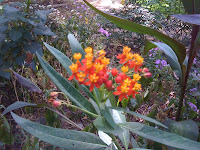 |
| monarch-butterfly.com |
October is here, and thankfully, cooler temps have finally arrived. Something else will be arriving in our gardens this month, too! October is the month when Monarch butterflies make their annual migration to Mexico; and our fair city of Grapevine, Texas, is right on their flight path (part of what's called the Central Flyway). As these colorful flying beauties head southward, they will be stopping in our gardens to refuel on the sweet nectar provided by the blooms of many annuals and perennials.
I learned from the Monarch Butterfly Website that Monarch butterflies (the "king" of butterflies) go through four stages during one life cycle (egg/larvae/pupa/adult), and through four generations in one year. The four generations are actually four different butterflies going through these four stages during one year until it is time to start over again with stage one and generation one.
In February and March, the final generation of hibernating Monarch butterflies comes out of hibernation to find a mate. They then migrate north and east in order to find a place to lay their eggs. This starts stage one and generation one of the new year for the Monarch butterfly.
In March and April the eggs are laid on milkweed plants. After about four days the eggs hatch into baby caterpillars (larvae). After about two weeks of munching on milkweed, the caterpillar will be fully grown and will attach itself to a stem or a leaf so that it can start the process of metamorphosis, transforming into a chrysalis. After 10 days of the chrysalis phase, the adult Monarch butterfly will emerge from the pupa and fly away. This first generation Monarch only lives about two to six weeks, and it dies after laying eggs for generation number two.
 |
| monarch-butterfly.com |
The second generation of Monarch butterflies is born in May and June, and then the third generation will be born in July and August. These Monarch butterflies will go through exactly the same four-stage life cycle as the first generation did, dying two to six weeks after it becomes a beautiful Monarch butterfly.
The fourth generation of Monarch butterflies is a little bit different than the first three generations. The fourth generation, born in September and October, goes through exactly the same process as the first, second, and third generations except for one part. The fourth generation Monarch does not die after two to six weeks. This is the generation that migrates to warmer climates like Mexico and California and will live for six to eight months until it is time to start the whole process over again.
For more information about the life cycle and migration
of these amazing butterflies, go to the Monarch Butterfly Website.
And come celebrate the Monarch migration at the 13th annual
held in downtown Grapevine on October 16, 2010.
This family event includes a parade and releases of butterflies, as well as butterfly exhibits, gardening seminars, and all sorts of interactive butterfly arts, crafts, and entertainment.
This family event includes a parade and releases of butterflies, as well as butterfly exhibits, gardening seminars, and all sorts of interactive butterfly arts, crafts, and entertainment.

These Monarchs hit pay dirt when they found this Butterfly Bush (Buddleia)
Eupatorium coelestinum is a Monarch magnet!
for attracting Monarchs to your garden are...
Fall Aster (Aster oblongifolius) ...
...and Mexican Bush Sage (Salvia leucantha).
Mexican Butterfly Weed
a/k/a Milkweed
(Asclepias curassavica)
a/k/a Milkweed
(Asclepias curassavica)
is a must-have larval and nectar source.
Monarch aren't the only butterflies I've seen flitting around these days.
Here are a few others...
Eastern Tiger Swallowtails
are attracted to Summer Phlox (Phlox paniculata)
Plant Dill, Fennel, and Parsley as larval sources for Black Swallowtails.

Black Swallowtail
(male)
Black Swallowtail
(female)
This Gulf Fritillary is getting a sip of nectar from a 'Profusion' Zinnia.
Passionvines (Passiflora incarnata) are a favorite larval source.
This Cloudless Sulphur butterfly is content on Rosemary flavored nectar.
Did you know that there are almost 500 species of butterflies in Texas?!
A couple more resources for butterfly info:
Butterflies of North America by James P. Brock and Kenn Kaufman
and
The term "flying colors" means to succeed at easily, to breeze through. I hope that all of your gardening endeavors this fall are a complete success and that you breeze through all of your projects with flying colors!
A version of this post appears as an article I wrote for the Grapevine Garden Club October newsletter.
Until next time...
Enjoy your gardens...and the butterflies
Toni :-)











Hard to imagine that a butterfly can migrate. Physically survive the dangers and have enough energy and tenacity to get there and back. Now THAT is flying your colours!
ReplyDeleteElephant's Eye:
ReplyDeleteExcellent comment! I would love to see where the Monarchs congregate in Mexico sometime. The pictures are amazing -- thousands and thousands of butterflies in the trees.
Dear Toni I am loving the Monarch butterfly.
ReplyDeleteLucky fourth generation! I enjoyed reading this post, and I really liked all the butterfly photos, especially the ones taken in your garden.
ReplyDeleteI'm always looking for more butterfly plants Toni. I've grown Butterfly Weed up north and will be getting some for the season ahead.
ReplyDeleteOh look again at your Black Swallowtail female...what you have there is a Giant Swallowtail. One of my very favorites! Kaufman's is the best Field Guide, my fav! Do you still get butterflies this time of year? It gets pretty cold here in northern Alabama :-( but I get a moth or two if it the sun comes out and it warms up a bit!